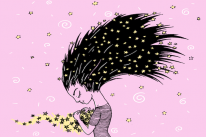
“Your mind, emotions, and body are instruments and the way you align and tune them determines how well you play life.” ~Harbhajan Singh Yogi
The earliest memory of my anxiety was at ten years old in fifth grade.
I remember it so vividly because in middle school the bus came at 6:22am exactly in the morning.
Each night I would look at my Garfield clock and think, “If I fall asleep now, I’ll get five hours of sleep…. If I fall asleep now, I’ll get four hours of sleep… If I fall asleep now, I’ll get three hours of sleep…”
And without fail, my sister would slam my door open at 6:15 because my alarm didn’t wake me, yelling that we’re going to miss the bus, and this is the last time she’s going to wake me up.
I didn’t know I had anxiety.
When my doctor asked my mother, “How is she sleeping?” the answer was always “She’s never been much of a sleeper.” And that was that.
Or when I couldn’t concentrate in school and do my homework, the “answer” was ADHD and I was given medication, which helped a little but didn’t solve the problem.
In high school, the anxiety about going to school was worse. I couldn’t eat breakfast because I was too nauseous in the morning from stress.
By college, my TMJ was so bad that there were months when I could barely open my mouth because my jaw was so tight. I had started scraping at my knuckles with a dull butter knife as a physical distraction from the angry swirl of anxiety in my stomach.
More of this as the years went on.
In my late twenties, after panic attacks that sent me to the emergency room, codependent relationships driven by the fear of rejection, and a wreck of a body with daily tension headaches, stomach issues, and a barely existent immune system… I finally figured out that this was all anxiety.
It was starting to make sense why my pursuit of symptom relief for all my physical ailments was not working—I wasn’t getting to the root of the problem.
In came meditation into my life.
And it helped—a lot!
It helped calm me. It taught me how to breathe properly. It gave me time every day to care for myself.
And because I was also practicing yoga, eating a healthy, vegetarian diet, going to the gym, smoking pot, and taking medication, my anxiety symptoms improved. But my anxiety didn’t go away… yet.
Without really understanding what anxiety is and why meditation helps (and what is missing from the equation), I was stuck from progressing further in my recovery.
What is Anxiety, Really?
We often confuse stress and anxiety.
Stress is an important bodily system.
Stress happens when a triggering event (like a bear or a tight deadline) activates our sympathetic nervous system to send cortisol and adrenaline through our body so that we can fight or flee our situation in order to keep ourselves safe.
It diverts energy and resources from “non-essential” systems like digestion and reproductive and immune systems so that it can divert it to our heart, lungs, and large muscles.
This is a reaction that lasts give or take twenty minutes (or until the immediate danger is no longer present).
Anxiety is when our thoughts continually activate our stress response.
While our bodies are built to recover from acute stress, they were not built for prolonged stress.
And that’s why we end up with symptoms like:
- Exhaustion
- Muscle tension
- Gastro-intestinal disorders
- Immune suppression
- Fertility and menstrual disorders
- Headaches
- (and like a hundred other things)
How Meditation Can Help with Anxiety
Like I said, I was definitely seeing the benefits of meditation, but I wasn’t seeing more progress with my anxiety.
That’s when I realized I had to change how I meditated and learned how to “practice” even when I wasn’t meditating.
Meditation is more than just focusing on your breath. It is a training exercise for your mind.
The goal isn’t to relax (though that is often a wonderful side effect), it is to change your relationship with the thoughts that come into your head.
That was the first lesson that made a world of difference in my practice, learning that “you are not your thoughts.” It blew my mind at first, but then it made sense. I have thoughts. I have ideas, stories, and sentences constructed by my brain to try to explain a situation. They are not me or the truth, just neurons firing off ideas.
A focused-attention meditation, like mindfulness meditation, teaches us three main things: notice, acknowledge, and redirect.
When we meditate, we notice when our attention has been taken away from our focal point (like our breath).
Then we acknowledge this without judgment, maybe even label what we were thinking about like “planning” or “worrying.”
And then we gently release our hold on that thought and redirect our attention back to where we want it—our breath.
This process of noticing, acknowledging, and redirecting teaches us how to:
- Be in the present moment
- Become consciously aware of our thoughts
- Choose curiosity over judgment
- Practice self-compassion and patience
- Let go of control
These are all skills essential to learning how to relate differently to the thoughts that cause our anxiety.
Once I started thinking of meditation as practice—like football practice—I began to realize that each two, five, or twenty-minute session of meditation was really preparing my mind to handle the real-world stressors off of my meditation cushion.
So, when I texted a friend and she didn’t text back (an old trigger of mine), I was learning how to:
- Notice: “Ah, I’m feeling anxious because I am thinking the reason she hasn’t replied is because she doesn’t like me as much as I like her, and I’m believing that her reply would prove that I am good enough and likable.”
- Acknowledge: “This is an uncomfortable feeling, but I will allow it to be here until it has passed. Even though she hasn’t replied, I choose to love and accept myself.”
- Redirect: “I open to the possibility that her lack of reply could have another explanation—she may be busy or sick or forgot to reply. I can wait or I can message her again. Even if she is angry with me, I can make amends because I am a good person.”
Instead of swirling down the rabbit hole of “what is wrong with me?”, I was learning to recognize these thoughts as just ideas that my brain served up based on a habit I’d cultivated after years of believing I wasn’t good enough.
While this understanding didn’t stop me from having those thoughts, it reduced them, and it taught me to change my relationship with them. Instead of believing them as truth, I was now able to see them for what they are—a defense mechanism to try and keep me safe.
But even after I understood that meditation is really a training practice, I was still missing an important piece of how it can help with anxiety.
Even though I had made huge strides with my anxiety, I still kept feeling some of the physical symptoms that went along with it like tightness in my chest and a constriction in my throat.
This is when I learned that meditation engages our parasympathetic nervous system—our rest and digest mode.
We have a sympathetic nervous system to engage our defenses, and a parasympathetic nervous system to disengage that defense system.
That’s why we often find meditation relaxing. Anxiety keeps our fight-or-flight mode engaged, so by slowing down, focusing on the breath, and relaxing our body, we’re able to tell our nervous system that we’re safe and it’s okay to chill out.
Our Emotions Get Stored in our Bodies
Even though I’d made huge progress in disengaging from anxious thoughts, and I was able to stop believing the ideas that “I’m not good enough and no one likes me,” I still felt that physical anxiety tension in my body.
That’s the piece that was missing for me for many years—the knowledge that our emotions get stored in our physical body. By that I mean we carry a muscle memory of how our body responded to our stress triggers in the past.
Have you ever had a meeting coming up that you know you are ready for, yet still you feel nervous? Or you try to relax, and you have nothing to be stressed about, yet your body is still tense? That’s what I’m talking about.
While meditation helped me reduce these physical symptoms, I still held that tension. I came to realize that we each need find the right tools for us—beyond meditation—to continually and regularly engage our calming systems.
There are lots of ways to do that. Practicing yoga, walking or dancing, laughing, singing, petting a cute puppy… all of which helped me some.
There are other embodiment practices as well that can send sensory information directly to our vagus nerve (a huge part of our parasympathetic system) that we are safe and we can relax
I found it fascinating to learn that it is our nervous system that creates our muscle tension. For example, if you were put under anesthesia, your muscles would go limp. Once you woke up, your nervous system would remember where it was tense and tighten back up.
This feeling of physical tension sends a signal back up to our brains that we are not completely safe, and that’s why it’s hard to shake that feeling of anxiety even when all is well.
The practices in addition to meditation that helped me personally to release that lingering tension were things like:
- Acupuncture (I had a huge physical release after a session once that blew my mind!)
- Tapping (EFT)
- Reiki
- Kundalini breathwork
- And a few simple vagal nerve stimulation practices that send sensory information directly to the nervous system
One example of vagal nerve activation is to lie on the floor with your nose pointed toward the ceiling. Using just your eyes, look to the right and hold the gaze until you notice a shift in your energy, a need to swallow, a sigh, or a deep breath. Then relax back at neutral and repeat by looking off to the left.
If you’ve practiced meditation to help with your anxiety and it didn’t work, or didn’t completely work, try the notice, acknowledge, and redirect technique I mentioned above to take power back from anxious thoughts. And if you still feel the emotions trapped in your body, perhaps trying new embodiment practices can help you release that stored tension.
About Sandy Woznicki
Sandy Woznicki is a stress coach helping parents find their inner calm and get to know, like, and trust themselves (so they can be the person, parent, and partner they are meant to be). Learn how to speak to yourself like someone you love with this free inner voice makeover workbook.













 Though I run this site, it is not mine. It's ours. It's not about me. It's about us. Your stories and your wisdom are just as meaningful as mine.
Though I run this site, it is not mine. It's ours. It's not about me. It's about us. Your stories and your wisdom are just as meaningful as mine. 